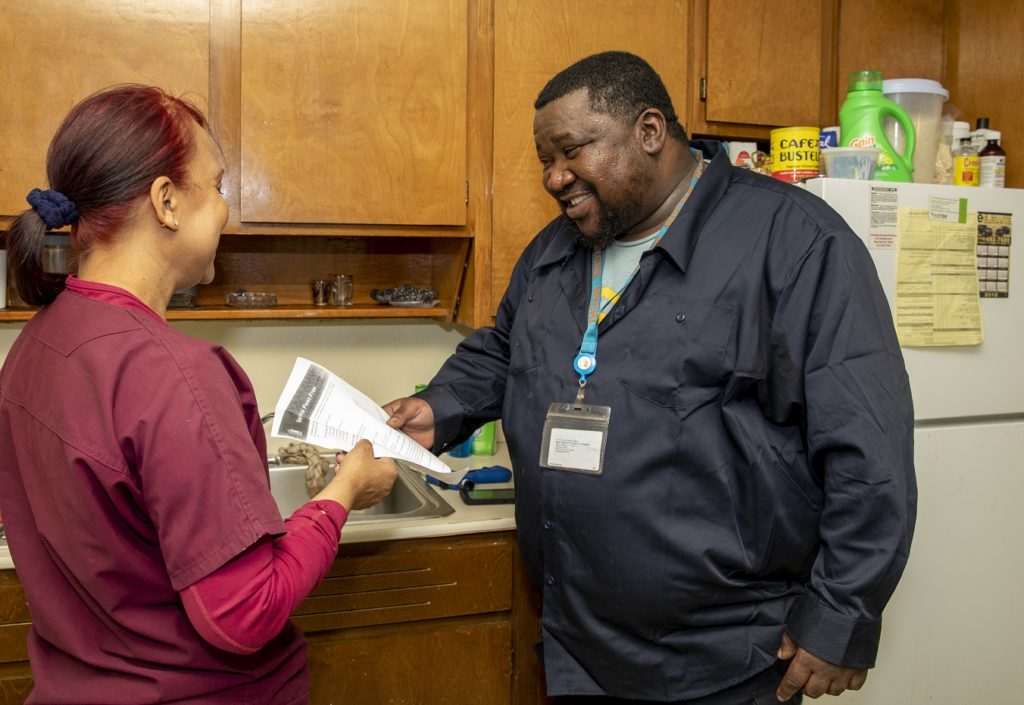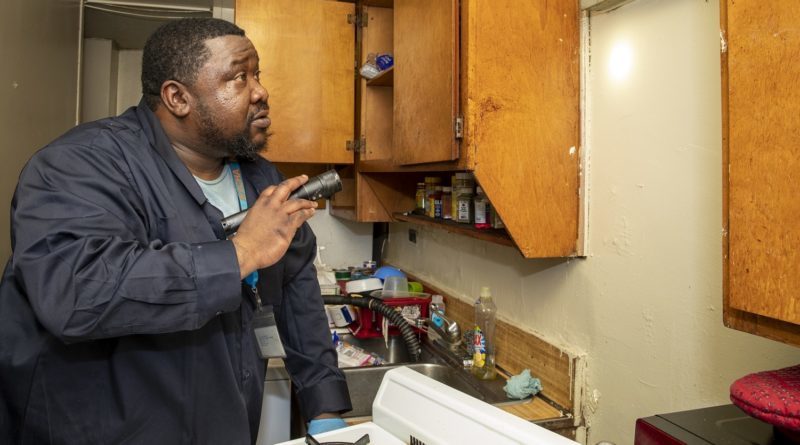Hunting for Clues and Keeping Out Pests
When he visits a development, Shawn Adams first interviews witnesses, often residents and caretakers who were last to see the intruders. He wants to know how they got in and how they got out. Then he looks for clues. Next, he finds where they are hiding and either eliminates them or bars their reentry.
Mr. Adams is a NYCHA exterminator who approaches his work like a detective. He’s been doing it for 10 months as a member of the Authority’s Prevention and Intervention Strategies Department. Before that, he worked for the NYC Department of Health for several years, where he focused on rodent reduction. He is licensed to treat for a wide variety of pests: rodents, bed bugs, beetles, roaches, ants, fleas, ticks, mosquitos, and other biting insects.
Depending on the case, he will employ different tools, some as small as a jeweler’s magnifying glass, which he uses to probe for bed bug larvae in crevices and baseboards, and some larger, a telescopic inspection mirror that allows him to see behind pipes and under tight sink spaces to search for insects and mouse holes. He also carries the standard one-gallon pesticide sprayer.
But as part of NYCHA’s Integrated Pest Management (IPM) strategy, which targets the underlying causes of infestation by improving building conditions, he applies pesticides only when he sees pests or signs of them. Mostly, he seals entry points and cracks that pests can wiggle through – a mouse can enter through a hole the width of a pencil – and he vacuums and wipes down areas to eliminate any residue not only for sanitary reasons but also because that’s how some pests tell others that food is at hand.
If his witnesses point to the outside grounds, Mr. Adams will flag any openings, which sometimes have recently excavated dirt, then collapse them with a shovel. He will return a week later to see which have reopened. Those are the active ones that need further treatment. “Each is part of a three-burrow network,” he explained. “One hole is the entry, another is the exit, and the third is an emergency escape.”
The burrows can be addressed in several ways. The most basic is “burrow harassment”; the exterminator just keeps collapsing the burrows with a shovel until the furry occupants decide that it’s too much work to remain and go elsewhere. Another way is the placement of dry ice in burrow openings. As the ice melts, it releases carbon dioxidegas, a pet-safe and humane solution that affects only the burrow space.
The most effective way, however, is prevention. “Help us help you,” Mr. Adams often tells residents. “Humans are a rodent’s best friend. Uncovered trash bins are a rich source of food. Walk a few extra feet to place trash bags in the right place. Don’t leave it in the elevator or in the hallways; use a garbage chute or leave it in a designated area inside a covered garbage can. The lid must be used and there must be a tight fit. Having a metal bin and not using the lid is like having a great security door but leaving it unlocked and ajar so anyone and anything can get in.”
“Inside the apartments, sinks should be dry, wiped down after every use,” he continued. “Some bugs need water to survive but can survive on mere wet surfaces, such as just-washed plates, a countertop, or a sink. It’s better to cloth-dry plates and silverware than to air-dry them.”
“To keep our homes safe,” Mr. Adams said, “we want to keep intruders and unexpected guests from ever entering – or wanting to enter.”


